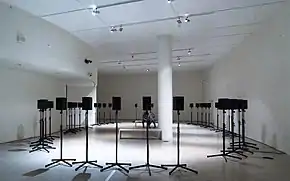Spem in alium
Spem in alium (Latin for "Hope in any other") is a 40-part Renaissance motet by Thomas Tallis, composed in c. 1570 for eight choirs of five voices each. It is considered by some critics to be the greatest piece of English early music. H. B. Collins described it in 1929 as Tallis's "crowning achievement", along with his Lamentations.[1]
| Spem in alium | |
|---|---|
| by Thomas Tallis | |
 Composer Thomas Tallis | |
| English | "I have never put my hope in any other but in Thee, God of Israel" |
| Genre | Renaissance Choral music |
| Form | Motet |
| Text | Matins responsory from the Sarum Rite |
| Language | Latin |
| Composed | c. 1556/1570 |
| Scoring | 40 voices a cappella |
History

The work's early history is obscure, though there are some clues as to where it may have been first performed. It is listed in a catalogue of the library at Nonsuch Palace, a royal palace sold in the 1550s to the Earl of Arundel before returning to the crown in the 1590s. The listing, from 1596, describes it as "a song of fortie partes, made by Mr. Tallys". The earliest surviving manuscripts are those prepared in 1610 for the investiture as Prince of Wales of Henry Frederick, the son of James I.
A 1611 commonplace book by the law student Thomas Wateridge contains the following anecdote:
In Queen Elizabeths time þere was à songe sen[t] into England in 30 p[art]s (whence þe Italians obteyned þe name to be called þe Apices of þe world) wch beeinge Songe mad[e] a heavenly Harmony. The Duke of — bearinge à great love to Musicke asked whether none of our English men could sett as good à songe, and Tallice beeinge very skilfull was felt to try whether he would undertake þe matter, wch he did & made one of 40 p[ar]tes wch was songe in the longe gallery at Arundell house, wch so farre surpassed þe other that the Duke, hearinge þt songe, tooke his chayne of Gold fro[m] his necke & putt yt about Tallice his necke & gave yt him (wch songe was againe songe at þe Princes coronation).[2][3][4]

Supposing the "30" to be a mistake, the Italian song referred to has been argued to be either the 40-part motet Ecce beatam lucem or the 40–60-voice mass Missa sopra Ecco sì beato giorno, both by Alessandro Striggio,[5] who is known to have visited London in June 1567 after a trip through Europe during which he arranged other performances of Missa sopra Ecco sì beato giorno.[6] This account is consistent with the catalogue entry at Nonsuch Palace: Arundel House was the London home of Henry FitzAlan, 19th Earl of Arundel; Nonsuch Palace was his country residence. Nonsuch had an octagonal banqueting hall, which in turn had four first-floor balconies above the ground floor; on this supposition it could have been the case that Tallis designed the music to be sung not only in the round, but with four of the eight five-part choirs singing from the balconies.
Likewise, the only dukedom extant during Elizabeth I's reign was that of Norfolk, so the duke in the letter can only be Thomas Howard, 4th Duke of Norfolk, and so (if the anecdote is trustworthy) his execution in 1572 gives a latest date for the work's composition. Some scholars consider that the Duke of Norfolk commissioned Tallis to write "Spem in alium" for performance at Nonsuch, and that its first performance took place there.[7] Other historians, doubting the anecdote, suggest that the first performance was on the occasion of Elizabeth's 40th birthday in 1573.[8]
The above are the most widely held views, but both have difficulties. The text comes from a response in the Matins order in the Sarum rite, which had been superseded by the Book of Common Prayer. Indeed, the text used for a 1610 performance of the work, while set to the music, is entirely different, suggesting that the original text was not satisfactory. Wateridge's letter is dated 40 years after the Elizabethan date and does not mention either Striggio or the duke by name. It has been suggested that if the duke in question was a duke of Norfolk this could be the third duke, who was alive during Mary I's reign. Nonsuch Palace belonged to the Norfolks in the 1550s, having been sold to them by Mary. As for the original text, its context of Judith slaying Holofernes and regaining her position fits with Mary's execution of the Duke of Northumberland, who had attempted to supplant her on the throne with Lady Jane Grey, rather than Tallis using it for Elizabeth. The music itself is entirely different from Striggio's setting. His work was for ten four-part choirs; Tallis's is for eight five-part choirs. The '30' in Wateridge's letter may not be a misprint or an error; the work referred to may be simply unknown. On these arguments Tallis wrote the work for Mary, Elizabeth's predecessor. The possibility has been advanced that Striggio copied Tallis, though of this there is no evidence.[9][7]
An early score of the work resides at the Bodleian Library, Oxford, where it was part of an exhibition shown in 2008–09 detailing 1000 years of British choral music.[10] Another early score of the work resides at the British Library, London in the Sir John Ritblat Treasures Gallery, where it was part of the 2014–15 exhibition "Treasures of the British Library".
Qualities
The motet is laid out for eight choirs of five voices (soprano, alto, tenor, baritone and bass). It is most likely that Tallis intended his singers to stand in a horseshoe shape. Beginning with a single voice from the first choir, other voices join in imitation, each in turn falling silent as the music moves around the eight choirs. All forty voices enter simultaneously for a few bars, and then the pattern of the opening is reversed with the music passing from choir eight to choir one. There is another brief full section, after which the choirs sing in antiphonal pairs, throwing the sound across the space between them. Finally all voices join for the culmination of the work.
Though composed in imitative style and occasionally homophonic, its individual vocal lines act quite freely within its elegant harmonic framework, allowing for a large number of individual musical ideas to be implemented during its ten- to twelve-minute performance time. The work is a study in contrasts: the individual voices sing and are silent in turns, sometimes alone, sometimes in choirs, sometimes calling and answering, sometimes all together, so that, far from being a monotonous mass, the work is continually changing and presenting new ideas.
Text
The original Latin text of the motet is from a responsory (at Matins, for the 3rd Lesson, during the V week of September), in the Sarum Rite, adapted from the Book of Judith (Judith 9).[11] Today the response appears in the Divine Office of the Latin rite in the Office of Readings (formerly called Matins) following the first lesson on Tuesday of the 29th Week of the Year.
There is no early manuscript source giving the underlay for the Latin text: the 1610 copies give the underlay for the English contrafactum, sung at the 1610 investiture of Henry Frederick, Prince of Wales, "Sing and glorify" (see below), with the Latin words given at the bottom.[11]
Latin
- Spem in alium nunquam habui
- Praeter in te, Deus Israel
- Qui irasceris et propitius eris
- et omnia peccata hominum
- in tribulatione dimittis
- Domine Deus
- Creator caeli et terrae
- respice humilitatem nostram
English translation
- I have never put my hope in any other
- but in Thee, God of Israel
- who canst show both wrath and graciousness,
- and who absolves all the sins
- of man in suffering
- Lord God,
- Creator of Heaven and Earth
- Regard our humility
English contrafactum (1610)
- Sing and glorify heaven's high Majesty,
- Author of this blessed harmony;
- Sound divine praises
- With melodious graces;
- This is the day, holy day, happy day,
- For ever give it greeting, Love and joy
- heart and voice meeting:
- Live Henry princely and mighty,
- Harry live in thy creation happy.
Renditions
Recordings include those by the Choir of Winchester Cathedral; the Tallis Scholars, The Cardinall's Musick, the National Youth Choir of Great Britain, the Oxford Camerata; the Choirs of King's and St John's Colleges, Cambridge; The Sixteen; The Clerkes of Oxenford; Huelgas Ensemble; Taverner Consort and Players; I Fagiolini have recorded it alongside a 40 part motet by Alessandro Striggio, with continuo, cornetts and sackbuts.

Another version of this motet is featured in Janet Cardiff's Forty-Part Motet (2001), a sound installation which is part of the permanent collection of the National Gallery of Canada in Ottawa, Ontario, Canada and of Inhotim in Brumadinho, Brazil. The Ottawa exhibit is set in the Rideau Street Chapel, which is the salvaged interior of a demolished convent chapel that is now in permanent display at the National Gallery. Forty speakers are set around the Chapel, each one featuring a single voice of the 40-part choir. The result is a highly enhanced polyphonic effect, as visitors may hear each individual voice through its corresponding speaker, or listen to the voices of the entire choir blending in together with varying intensities, as one moves around the Chapel.
On 10 June 2006, the BBC asked for 1,000 singers to meet, rehearse and perform the piece in the Bridgewater Hall, Manchester for what was almost certainly the largest performance of the piece in history. On that day, over 700 singers attended, most of whom had never sung the piece before. A programme following the day's events was broadcast on BBC Four on 9 December 2006.[12]
Spem in alium features prominently in the Stephen Poliakoff TV drama Gideon's Daughter. It is also used in the film Touching the Void, reaching a climax when Yates and Simpson arrive at the summit of the mountain. It appears again in Francois Girard's Boychoir (2014), performed "in-the-round" at Stet's early-training in the fictional National Boychoir Academy.[1]
Spem in alium has inspired modern composers to write 40-part choral works; examples include Giles Swayne's The Silent Land (1998), Robert Hanson's And There Shall Be No Night There (2002), Jaakko Mäntyjärvi's Tentatio (2006), Peter McGarr's Love You Big as the Sky (2007) and Alec Roth's Earthrise (2009), which was commissioned by the UK choir Ex Cathedra for its 40th anniversary. A London-based choral festival, the Tallis Festival, which always includes a performance of Spem in alium, commissioned both Mäntyjärvi and McGarr.[13]
In 2021 the Self-Isolation Choir will perform the work, trained and conducted by Nigel Short and led by singers from Tenebrae, with all singers recording their parts individually at home.[14] The edition used is that prepared by Hugh Keyte in 2020 and made available by the Thomas Tallis Society along with Keyte's 70-page introduction to the edition.[15][16][17] The Society also makes available learning material whereby a singer may hear a recording of any chosen voice line, with metronome and/or organ accompaniment.[18]
Recordings
- Tallis—Latin Church Music—Taverner Consort and Players, Andrew Parrott (EMI Reflexe, 1989)
- Thomas Tallis—Spem in alium—The Tallis Scholars (Gimell, 1985)
References
- Davitt Moroney, "Alessandro Striggio's Mass in Forty and Sixty Parts". Journal of the American Musicological Society, Vol. 60, No. 1 (Spring 2007), pp. 1–69. ISSN 0003-0139.
Notes
- Boychoir (film)
- Cambridge University Library, MS Dd.5.14, f.73v, quoted in Harley, John (2016). Thomas Tallis. London and New York: Routledge. pp. 149–150. ISBN 9781472428066., see figure 8.1 for a photograph of the relevant page of the original manuscript.
- This anecdote was first transcribed in Sheppard, Henry Fleetwood (1 February 1878). "Tallis and His Song of Forty Parts". The Musical Times and Singing Class Circular. 19 (420): 97–98. doi:10.2307/3358789. JSTOR 3358789.
- Cole, Suzanne (2008). Thomas Tallis and His Music in Victorian England. Boydell. p. 97. ISBN 978-1-84383-380-2.
- Dennis Stevens Early Music Vol 10 Issue 2 p.171ff
- Moroney, pp. 28–33.
- Baker, Michael; Steel, George. "The Story of Spem in alium" (PDF). Retrieved 24 May 2018.
- Thomas Kahlcke, in sleevenotes to "The Tallis Scholars: Best of the Renaissance" (Philips 1999)
- George Steel (March 2002). "The Story of Spem in alium". Andante. Archived from the original on 26 April 2009.
- "Bodleian Libraries Website". Retrieved 17 February 2014.
- Long, Siobhán Dowling; Sawyer, John F. A. (2015). "Spem in Alium". The Bible in Music: A Dictionary of Songs, Works, and More. Rowman & Littlefield. p. 226. ISBN 9780810884526. Retrieved 23 May 2018.
- "The People's Chorus". BBC.
- "Tallis Festival | Exmoor Singers of London". www.exmoorsingers.org. Retrieved 1 October 2016.
- "Spem in Alium". The Self-Isolation Choir. Retrieved 24 June 2021.
- "Spem in Alium: Preface" (PDF). Thomas Tallis Society. Retrieved 20 August 2021.
- Keyte, Hugh (2020). Spem in Alium: Editor's introduction (PDF). Thomas Tallis Society. Retrieved 20 August 2021.
- Spem in Alium (full score) edited by Hugh Keyte (PDF) (2020 ed.). Thomas Tallis Society. Retrieved 20 August 2021.
- "Tallis' Virtual Voice – Resources – Thomas Tallis Society". Retrieved 22 August 2021.
External links
- Complete performance by the Tallis Scholars, followed by 10-minute discussion on BBC Radio 3 (28 October 2007) [RTP stream metadata; requires compatible player]
- Choral Public Domain Library (with further discussion of the work, as well as complete score and singers' editions for each of the eight choirs, available for free legal download).
- Notes by Peter Phillips for the Tallis Scholars recording
- Notes by Jeremy Summerly for the Oxford Camerata recording
- The Early Music Show
- Brighton Consort's MIDI Set offers midi files of each choir and each part within each choir for practice. (no longer available at this location)
- Straight into the charts... a hit from 1568.